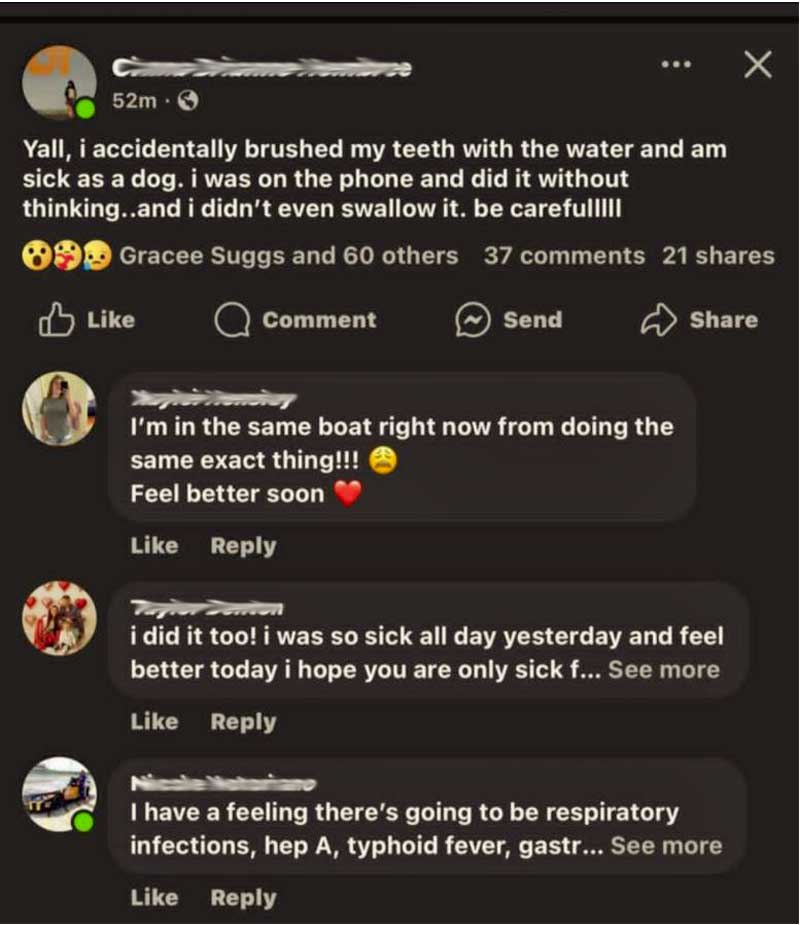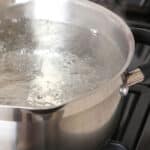Boil Water Advisory – Safety and Water Use Tips
This post may contain affiliate links. Read my full disclosure here.
Most people know about boiling water to make it safe to drink, but sometimes boiling isn’t enough. We’ll share when boiling works to make water safe, when it doesn’t, and what to do during a boil water advisory.

What is a Boil Water Advisory?
Public health officials issue a boil water advisory when contaminants enter the water supply that can make you sick. During the boil water order, use boiled or bottled water for drinking or cooking.
Public water systems stuggle with aging infrastructure and shifting weather patterns. Too much rain and too little rain both put stress on water supplies.
Boiling tap water only kills microorganisms. It does not remove particulates, heavy metals, nitrates, or many other chemicals. This is important, because if you boil some types of contaminated water, you concentrate the chemicals and make it worse. Filtering or distillation is a safer option for removing these contaminates.
During a boil water advisory, the simple solution is bottled water or emergency water storage. But bottles may be hard to get, and you might need more water than you can store. Note – It’s fine to reuse clean, empty bottles to store your boiled water.
How to Boil Water During an Advisory
You’ll need a pot or kettle and a heat source, such as a stove or a campfire. Here’s how to do it:
- Fill the pot or kettle with water. If the water isn’t clear, pre-filter it with a clean cotton shirt or coffee filter to remove debris.
- Place the pot on the stove, grill or campfire. (Make sure to use a flame resistant pot if heating over an open flame.)
- Turn the heat on high and then wait for the water to come to a rolling boil.
- Once the water is boiling, let it boil for at least one minute to make it safe to drink. At elevations above 6,500 feet, boil for 3 minutes.
- Turn off the heat and let the water cool before drinking it.
** WARNING: Boiling water and steam can cause instant severe burns. Always use caution when handling containers filled with boiling hot water. Use heat-resistant gloves or oven mitts to protect your hands.**
The Bruntmor Cast Iron Dutch Oven and AceCamp Cooking Pot can be used on a stove-top or over open flame.
How to Boil Water in a Microwave
- Find a microwave safe container, such as a 4 cup or 8 cup glass or ceramic bowl.
- Fill it with tap water (filter the water if there are obvious contaminants in the water).
- Run microwave on high until water is at a rolling boil for at least 2 minutes.
- WAIT a few minutes, and then carefully open the microwave and let the steam out. Make sure you are careful when you open the microwave, as the steam can easily burn you.
- After the steam clears, use oven mitts to remove the container and let it cool completely.
- Wipe the inside of the microwave dry. (This is also a good way to remove stuck on food.)
REMEMBER: Don’t drink tap water until your local water authority lifts the boil water advisory.
When Boiling Works, and When it Doesn’t
Boiling water kills harmful organisms such as protozoa, bacteria, viruses, and parasites. When you boil water, the high temperature destroys these microorganisms and makes the water safer to drink.
Boiling water does not remove heavy metals like lead, arsenic or chemicals like nitrates or fluoride. You need a filter to remove inorganic contaminates.
Boiling can condense or concentrate contaminants. Sometimes heat breaks down inorganic compounds, changing one hazardous material into another. This means that boiling can, in some cases, result in even more hazardous drinking water. To eliminate the risk from these inorganic particles, you need a good water FILTER.
Filters and Other Options
If you are concerned about heavy metals or chemicals in your water, use a good water filter, or a distiller. We suggest activated carbon filters or reverse osmosis filters.
See “Emergency Water Storage and Filtration” for more information on filters.
Does Boiling Water Remove Nitrates?
NO. Boiling water is not effective in removing nitrates and nitrites from water.
Would you like to save this?
Nitrates are often found in groundwater and surface water in farming areas. High levels of nitrates in drinking water may be harmful, especially for infants and pregnant women. Consider a reverse osmosis water filter if you are concerned about nitrates/nitrites.
How to Sterilize Jars and Bottles to Safely Store Water
If you plan to store water in jars or bottles, it’s important to sterilize them to prevent contamination. Here’s how to do it:
- Clean the jars or bottles thoroughly with soap and water. You can use contaminated tap water with soap. Alternately, you can wipe the container with alcohol and let it air dry.
- Fill a large pot with water and bring it to a boil. It should be about 4/5ths full – not completely full.
- Place the jars or bottles in the pot and boil them for 10 minutes.
- Use tongs to remove the jars or bottles from the pot and let them cool.
- Do not fill the storage bottles, until the water and jar are both cool.
- Alternately, you can fill a hot jar with hot water, and cover with a lid. The jar will seal as the water cools. (You want to avoid extreme temperature differences, which can cause the jar to break.)

Water Use During a Boil Water Advisory
You local health officials should tell you how bad the problem is. It may be okay to use the water for hand washing, showering, and hair washing, but if contamination is bad, it may not.
For hand washing, use soap and scrub for at least 20 seconds. Rinse well and dry thoroughly. Be careful not to swallow any water while bathing or showering. Use a sponge bath for babies and young children who are more likely to swallow water.
Use Bottled or Boiled Water for:
- Drinking water for you and your pets.
- Mixing baby formula.
- Water for cooking and drink mixes.
- Brushing your teeth.
- Wash Dishes (by hand)
It is not safe to use ice makers or unfiltered chilled water from a refrigerator dispenser. You can use the clothes washer as normal, and use the dishwasher on “Sanitize”. It is safe to flush the toilet.
If you accidentally drink water during a boil water advisory, don’t panic. What’s done is done. Take some probiotics to boost your immune system, and be mindful of any unusual symptoms. Avoid ingesting any more contaminated water.
How to Flush Your Dishwasher After a Boil Water Notice
For extra safety, flush your dishwasher after a boil water advisory before using it again. Here’s how to do it:
- Remove any dishes or utensils from the dishwasher.
- Add a cup of white vinegar OR bleach (sodium hypochlorite) to the washer.
- Run the dishwasher on the hottest cycle possible, using no detergent.
- Once the cycle is complete, open the dishwasher and let it air dry for at least an hour.

Related Articles

This post was written by August Neverman IV. August has a strong background in emergency preparedness. He served on several emergency preparedness teams during his tenure at Brown County WI Government, the Medical College of Wisconsin, HSHS, a 13-hospital system and emergency response training during his time with the Air Force and Air National Guard. Learn more about August.

